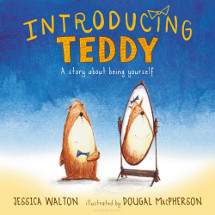Introducing Teddy by Jessica Walton

Ill. by Dougal MacPherson. Bloomsbury Books, 2016. ISBN
9781408877630
(Age: all) Highly recommended. Transgender, Being yourself,
Friendship, Acceptance. When Thomas the teddy is feeling low, his
friend Errol asks him what the matter is. Thomas is usually happy to
play and have picnics and go for rides on the bike or scratch around
in the garden. Thomas is unsure of what to say and asks Errol to be
his best friend no matter what he says.
Thomas reveals that he has never felt like a boy inside but feels
like a girl. He would prefer his name to be Tilly. Errol hugs teddy
to him, reassuring her that he likes her no matter what, they are
still best friends, and Errol calls her Tilly.
Errol decides to call their friend, Ava to come and play. She comes
over to the park where Errol introduces her to Tilly, and the two
discuss their bows. Tilly no longer wears a bow tie, but uses it to
tie her hair, while Ava discards her tie around her hair, wanting
her hair to be free. They play all morning, doing the things they
have always done, and later go home to play in the garden go for
rides on the bike and when they plan a picnic call Ava to come over
with her new friend, a robot she has built.
This is a wonderfully subtle story of inclusion, of remaining
friends no matter how the circumstances change. Ava and Errol's
acceptance of teddy's change of name is unconditional, they all
remain friends no matter what happens. When Thomas becomes Tilly
nothing changes between the group, Tilly simply states that she has
never felt like a boy teddy and so now wishes to be known as Tilly
not Thomas. Their friendship remains resolute.
It is also a tale of bravery, as teddy is concerned that when he
tells Errol about his worry, Errol will no longer be his friend.
Nothing is further from the truth. Errol's response is
overwhelmingly positive and supportive, giving a model for others to
follow which is reiterated when Ava joins them.
The mixed media illustrations are lovely, showing a young boy and
his teddy doing the things mentioned in the text. They are
inseparable, the crayon outlining the boy and his teddy against a
spare background. I love the repetition of the activities at the
start and end of the book, bringing the illustrations in a full
circle, showing nothing has changed after teddy's announcement.
Both author and illustrator are from Melbourne, the transgender
theme close to the author's heart and this book will become a book
of choice when discussions arise at home and in the classroom about
issues of gender.
Fran Knight
Editor's note: There is a Friendship
Activity pack available.